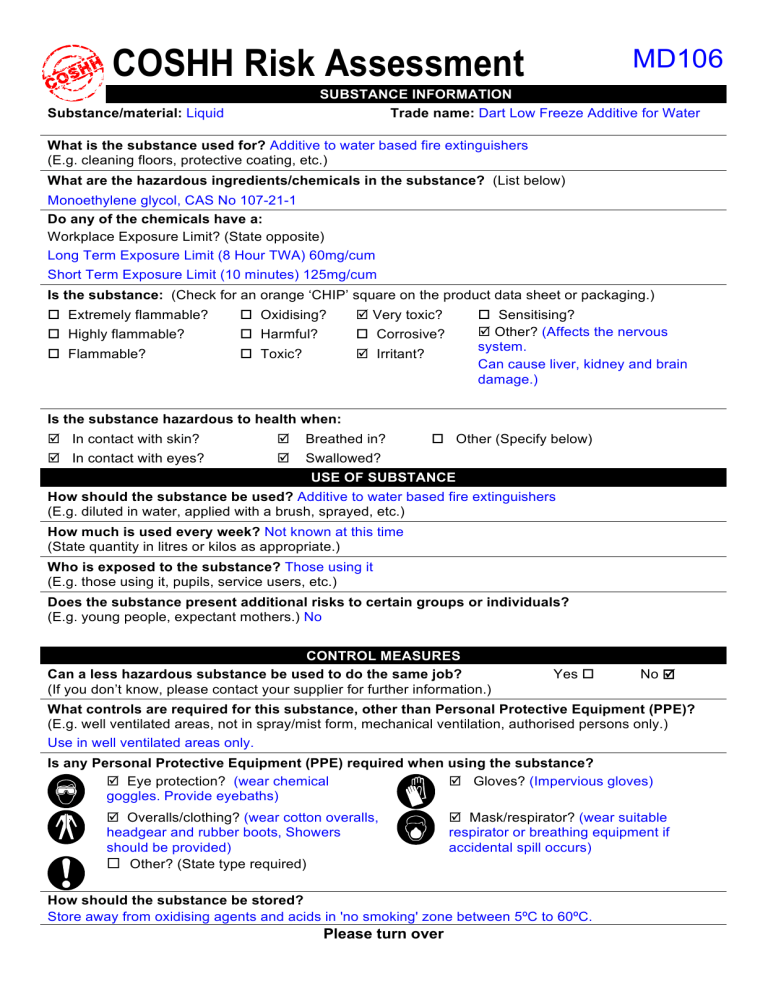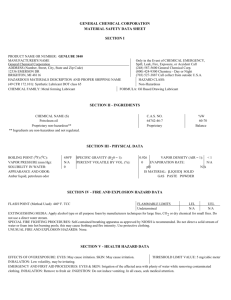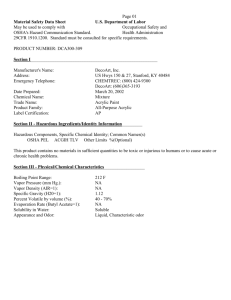
COSHH Risk Assessment MD106 SUBSTANCE INFORMATION Trade name: Dart Low Freeze Additive for Water Substance/material: Liquid What is the substance used for? Additive to water based fire extinguishers (E.g. cleaning floors, protective coating, etc.) What are the hazardous ingredients/chemicals in the substance? (List below) Monoethylene glycol, CAS No 107-21-1 Do any of the chemicals have a: Workplace Exposure Limit? (State opposite) Long Term Exposure Limit (8 Hour TWA) 60mg/cum Short Term Exposure Limit (10 minutes) 125mg/cum Is the substance: (Check for an orange ‘CHIP’ square on the product data sheet or packaging.) o Extremely flammable? o Oxidising? þ Very toxic? o Highly flammable? o Harmful? o Corrosive? o Flammable? o Toxic? þ Irritant? o Sensitising? þ Other? (Affects the nervous system. Can cause liver, kidney and brain damage.) Is the substance hazardous to health when: þ In contact with skin? þ Breathed in? þ In contact with eyes? þ Swallowed? o Other (Specify below) USE OF SUBSTANCE How should the substance be used? Additive to water based fire extinguishers (E.g. diluted in water, applied with a brush, sprayed, etc.) How much is used every week? Not known at this time (State quantity in litres or kilos as appropriate.) Who is exposed to the substance? Those using it (E.g. those using it, pupils, service users, etc.) Does the substance present additional risks to certain groups or individuals? (E.g. young people, expectant mothers.) No CONTROL MEASURES Can a less hazardous substance be used to do the same job? (If you don’t know, please contact your supplier for further information.) Yes o No þ What controls are required for this substance, other than Personal Protective Equipment (PPE)? (E.g. well ventilated areas, not in spray/mist form, mechanical ventilation, authorised persons only.) Use in well ventilated areas only. Is any Personal Protective Equipment (PPE) required when using the substance? þ Eye protection? (wear chemical þ Gloves? (Impervious gloves) goggles. Provide eyebaths) þ Overalls/clothing? (wear cotton overalls, headgear and rubber boots, Showers should be provided) ¨ Other? (State type required) þ Mask/respirator? (wear suitable respirator or breathing equipment if accidental spill occurs) How should the substance be stored? Store away from oxidising agents and acids in 'no smoking' zone between 5ºC to 60ºC. Please turn over Have persons using this substance been provided with information or training on its use? Yes þ (As a minimum ensure a copy of this assessment is in a known and readily accessible location.) No o OTHER PRECAUTIONS AND EMERGENCY PROCEDURES Spillages: How should an accidental release/spillage of this substance be dealt with? Personal precautions: wear gloves, mask, goggles and full protective clothing. Ventilate area if possible. Environmental precautions: contain with sand or earth and transfer to suitable container for correct disposal. Do not allow to enter water courses or drains. Methods of cleaning up: absorb onto earth or proprietary materials. Remove and wash site of spillage with water. First aid: What actions should be taken if the substance is: a) Swallowed? Wash out mouth with water and give ½ pint warm water to drink. Do not induce vomiting. Obtain medical attention urgently. b) In contact with eyes? Irrigate eyes thoroughly with water for at least 10 minutes, holding eyelids apart if necessary. Obtain medical attention. c) In contact with skin? Immediately wash with plenty of water, use soap if available. Remove contaminated clothing. Request medical aid if symptoms persist. d) Inhaled? At room temperature, exposure to vapour is unlikely. At high temperature, ventilation and suitable respiratory protection should be employed. e) Other? (Please specify.) Fire precautions: What actions should be taken in the event of fires involving this substance? Suitable extinguishing media: alcohol resistant foam, or water fog. Carbon dioxide and dry powder also suitable for small fires. Extinguishing media that must not be used: do not use water jets. Special exposure hazards: decomposes on heating to give toxic fumes of carbon monoxide, carbon dioxide and smoke. Special protective equipment for fire fighters: self-contained breathing apparatus and full protective clothing. Chemical reactions: Is there any other substance that this substance must not come into contact with? Stability of the substance: decomposes with heat to give oxides of carbon. Conditions to avoid: storing at high temperatures or close to oxidising agents or acids. Flammable. Materials to avoid: oxidising agents, oleum, sulphuric acid, and chlorosulphuric acid. Hazardous decomposition products: oxides of carbon: toxic carbon monoxide and carbon dioxide. Disposal: How should the substance be disposed of (or not disposed of)? Treat as for spillages –– see accidental release measures. Transfer any waste to suitable containers for subsequent disposal. Do not release to watercourses or drains. Health surveillance: Do staff using the substance require any health surveillance? No ASSESSMENT OF RISK Are all the controls detailed above currently in place? Yes þ No o If these controls are not in place, or additional controls are required, state action to be taken. Please note - COSHH substances must NOT be used if adequate control measures are not in place. Remedial actions required Are hazards to health adequately controlled with all control measures in place? Date for completion Yes þ No o Assessor(s) name: Chris Ogden Assessor(s) signature: Chris Ogden Date: 01/01/17 The Line Manager should sign below to show that the assessment is a correct and reasonable reflection of the hazards and of the control measures and actions required. Line Managers name: Line Managers signature: Date: Remedial actions complete: (Date) Line Managers signature: Reviewed on: A copy of the product safety data sheet must be attached to this assessment.



